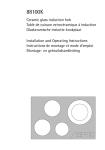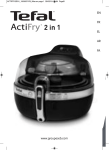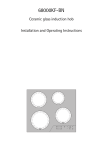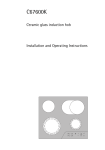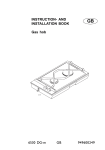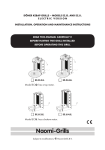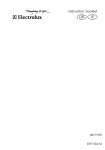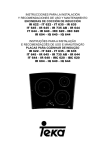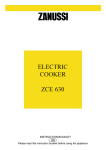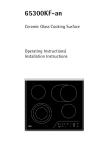Download Electrolux C68000K User's Manual
Transcript
C68000K Piano di cottura in vetroceramica induttivo laca vitrocerámica de cocción por inducción Ceramic Glass Induction Hob Placa de cerâmica de vidro indução Istruzioni di montaggio e per l'uso Instrucciones para el montaje y para el uso Installation and Operating Instructions Montagem e indicações de utilização Dear Customer, Please read these operating instructions through carefully. Above all, please take note of the “Safety” section on the first few pages. Please keep these operating instructions for future reference. Pass them on to any subsequent owner of the appliance. The warning triangle and/or specific words (Warning!, Caution!, Important!) are used to highlight instructions that are important for your safety or for the function of the appliance. It is imperative that these instructions are observed. 0 1. This symbol guides you step by step when operating the appliance. 2. ... 3. ... 1 3 Next to this symbol you receive additional information and practical tips on using the appliance. 2 Tips and information about the economical and ecological use of the machine are marked with a cloverleaf. Before calling out an engineer to a fault please read the chapter „What to do if...“ as you may be able to resolve the problem yourself. For further assistence contact your local AEG Service Force Centre, see the section „Service and Spare Parts“. Printed on paper manufactured with environmentally sound processes. He who thinks ecologically acts accordingly ... 70 Contents CONTENTS Operating Instructions . . . . . . . . . . . . . . . . . . . . . . . . . . . . . . . . . . . . 71 Safety . . . . . . . . . . . . . . . . . . . . . . . . . . . . . . . . . . . . . . . . . . . . . . . . . . . . . . . . 71 Disposal . . . . . . . . . . . . . . . . . . . . . . . . . . . . . . . . . . . . . . . . . . . . . . . . . . . . . . 74 Appliance Description . . . . . . . . . . . . . . . . . . . . . . . . . . . . . . . . . . . . . . . . . . Function and the Way the Induction Cooking Zone Works . . . . . . . . . . . . Features of the Ceramic Hob . . . . . . . . . . . . . . . . . . . . . . . . . . . . . . . . . . . . . Control Panel . . . . . . . . . . . . . . . . . . . . . . . . . . . . . . . . . . . . . . . . . . . . . . . . . . The Digital Displays . . . . . . . . . . . . . . . . . . . . . . . . . . . . . . . . . . . . . . . . . . . . . Cooking Zone Safety Switch . . . . . . . . . . . . . . . . . . . . . . . . . . . . . . . . . . . . . . Resetting the Safety Cut-Off . . . . . . . . . . . . . . . . . . . . . . . . . . . . . . . . . . . . . Suitable Kitchenware for Induction Cooking Zones . . . . . . . . . . . . . . . . . . 74 74 75 75 76 77 77 78 Before Using for the First Time . . . . . . . . . . . . . . . . . . . . . . . . . . . . . . . . . 80 Initial Cleaning . . . . . . . . . . . . . . . . . . . . . . . . . . . . . . . . . . . . . . . . . . . . . . . . . 80 Using the Cooking Zones . . . . . . . . . . . . . . . . . . . . . . . . . . . . . . . . . . . . . . . Switching on the Appliance . . . . . . . . . . . . . . . . . . . . . . . . . . . . . . . . . . . . . . Switching Off the Appliance . . . . . . . . . . . . . . . . . . . . . . . . . . . . . . . . . . . . . Cooking Zone Selection . . . . . . . . . . . . . . . . . . . . . . . . . . . . . . . . . . . . . . . . . Heat Level Selection + and - . . . . . . . . . . . . . . . . . . . . . . . . . . . . . . . . . . . . . Cooking without the Automatic Heating-Up Function . . . . . . . . . . . . . . . . Cooking with the Automatic Heating-Up Function . . . . . . . . . . . . . . . . . . . Activating the Power Function . . . . . . . . . . . . . . . . . . . . . . . . . . . . . . . . . . . Timer . . . . . . . . . . . . . . . . . . . . . . . . . . . . . . . . . . . . . . . . . . . . . . . . . . . . . . . . . Locking/Unlocking the Control Panel . . . . . . . . . . . . . . . . . . . . . . . . . . . . . . 80 80 81 82 82 83 84 86 87 89 Usage, Tables, Tips . . . . . . . . . . . . . . . . . . . . . . . . . . . . . . . . . . . . . . . . . . . . . Tips on Cooking with or without the Automatic Feature . . . . . . . . . . . . . . Tables . . . . . . . . . . . . . . . . . . . . . . . . . . . . . . . . . . . . . . . . . . . . . . . . . . . . . . . . Reference values for setting the cooking zones . . . . . . . . . . . . . . . . . . . . . Application Examples for the Automatic Heating-Up Feature . . . . . . . . . 89 89 90 90 91 71 Contents Cleaning and Care . . . . . . . . . . . . . . . . . . . . . . . . . . . . . . . . . . . . . . . . . . . . . Advantages for Cleaning and Caring for the Induction Cooking Zone . . . Glass Ceramic Cooking Surface . . . . . . . . . . . . . . . . . . . . . . . . . . . . . . . . . . . Problem Dirt . . . . . . . . . . . . . . . . . . . . . . . . . . . . . . . . . . . . . . . . . . . . . . . . . . . 92 92 92 93 What to do if ... . . . . . . . . . . . . . . . . . . . . . . . . . . . . . . . . . . . . . . . . . . . . . . . 95 Installation Instructions . . . . . . . . . . . . . . . . . . . . . . . . . . . . . . . . . . . Technical Data . . . . . . . . . . . . . . . . . . . . . . . . . . . . . . . . . . . . . . . . . . . . . . . . . Regulations, Standards, Directives . . . . . . . . . . . . . . . . . . . . . . . . . . . . . . . . . Safety Instructions for the Installer . . . . . . . . . . . . . . . . . . . . . . . . . . . . . . . . Electrical Connection . . . . . . . . . . . . . . . . . . . . . . . . . . . . . . . . . . . . . . . . . . . Service . . . . . . . . . . . . . . . . . . . . . . . . . . . . . . . . . . . . . . . . . . . . . . . . . . . . . 101 Installation 72 96 97 98 99 100 . . . . . . . . . . . . . . . . . . . . . . . . . . . . . . . . . . . . . . . . . . . . . . . . . 140 Operating Instructions OPERATING INSTRUCTIONS 1 Safety The safety aspects of this appliance comply with the accepted technical standards and the German Appliance Safety Law. However, we also consider it our obligation as a manufacturer to make you aware of the following safety information. Electrical Safety • The new appliance may only be installed and connected up by qualified personnel, according to the manufacturers instructions and to the relevant country standards. Please observe this instruction, otherwise the warranty will not cover any damage that may occur. • Repairs to the appliance should only be carried out by approved service engineers. Improper repairs can cause injury or significant malfunction. If your appliance needs repairing, please contact your local AEG Service Force Centre. • If your appliance malfunctions or fractures and cracks or splits appear: – switch off all cooking zones, – Disconnect the hob from the electricity supply. Child Safety The cooking zones will become hot when the hob is in use. Therefore, always keep small children away. The hob is designed to be operated by adults. Do not allow children to play near or with the hob Safety Whilst Using • This appliance may only be used for boiling and frying food in the home. • Take care when connecting electric appliances to sockets nearby. Connection cables must not be able to touch hot cooking zones. • Overheated fat and oil will catch fire quickly. You should supervise cooking when preparing food in fat or oil (e.g. chips). • Switch off the cooking zones after use. 73 Operating Instructions Special Notes on Induction Cooking Zones • Scientific studies have shown that patients who are fitted with implanted pacemakers are not normally affected or put at risk by our induction cooking zones. The distance between the body and the cooking zone should, however, never be less than 30 cm! • Electromagnetic fields can affect electronic circuits and interfere with portable transistor radios. • Do not put magnetically rechargeable objects (e.g., credit cards, cassettes) on the glass ceramic surface while one or more induction cooking zones are in use! • Do not put any metallic objects (e.g., spoons, pan lids) on the induction surface as they can be warmed up when the induction surface is in use. 3 Some cookware can produce noises when used on induction cooking zones. This is not a fault in the hob and its function will not be impaired in any way as a result. Safety When Cleaning • For safety reasons do not clean the appliance with a steam jet or high pressure cleaner. • Clean the hob in accordance with the maintenance and cleaning instructions in this manual. 74 Operating Instructions How to Avoid Damaging your Appliance • Do not use the cooking surface as a work surface or for storage. • Do not use the cooking zones with empty pots and pans. • Glass ceramic is insensitive to temperature shock and very robust, however it is not unbreakable. Especially sharp and hard objects that fall on the cooking surface can damage it. • Do not use pans with damaged bases that are rough and have burrs. Scratching may occur when the pans are slid. • Do not place any pans on the cooking surface frame. Scratching may occur or the paint damaged. • Make sure that no acidic liquids, e.g. vinegar, lemon or descaling agents are spilt onto the frame of the cooking surface, since these cause matt spots. • If sugar or a preparation with sugar comes into contact with the hot cooking zone and melts there it must be cleaned off immediately with a scraper while it is still hot. If it cools, damage to the surface may occur on removal. • Keep all items and materials that can melt away from the glass ceramic surface, e.g. plastics, aluminium foil, or oven foils. If something of this nature should melt onto the glass ceramic surface, it must also be removed immediately using the scraper. • Avoid boiling pans dry. The bases could be irreparably damaged in the process and the glass ceramic cooking surface also damaged. 75 Operating Instructions 2 Disposal Disposing of Packaging Materials • All packaging can be recycled, sheet and hard foam parts are appropriately marked. Please dispose of packaging material and any old appliance with due regard to safety and the environment. Information on disposal • The appliance must not be disposed of in the household rubbish. • You can obtain information about collection dates or public tips from your local Council or Environmental Health Office. • Warning! Before disposing of old appliances make them inoperable. Cut off the mains cable. Appliance Description Function and the Way the Induction Cooking Zone Works A copper wire induction coil is beneath the glass ceramic cooking surface. This generates electromagnetic fields, which act directly on the base of the pots and pans and not, as with other heating up methods, first heat up the glass ceramic. This means that the base of the pan is immediately heated up, which saves time and energy. Since the heat required for cooking is generated directly in the base of the pan the cooking zone itself hardly warms up. It only receives the reflected heat from the pan base. Note: If there is no pot or pan on the cooking zone there is no energy transfer (heating up) and therefore gives protection against the cooking zones being switched on accidentally. 3 76 A cooling fan is an integral part of this hob and comes on automatically depending on the temperature of the induction cooking zone. The cooling fan will continue to run for a short period after the cooking zone has been switched off. Operating Instructions Features of the Ceramic Hob Cooking zone 2: Induction cooking zone 1800 W Cooking zone 3: Induction cooking zone 1400 W Cooking zone 4: Induction cooking zone 1800 W with power function 2300 W Cooking zone 1: Induction cooking zone 2200 W with power function 3000 W Touch-control panel Control Panel Display timer Heat setting displays Interlock with indicator lamp Cooking zone displays Timer operation Timer Cooking zone selection Main button “On/Off” Power zone activation Cooking stage selection “+” and “-” 77 Operating Instructions The Digital Displays Digits 1 to 9 and four different letters can appear in the display. • The digits show the cooking stage set. 1 = Lowest capacity 9 = Highest capacity • The following letters and functions are displayed for the cooking zones: 78 1 H = Residual Heat Display Danger! Cooking zone still hot; it extinguishes when the cooking zone has cooled down. This display appears only if the cooking zone is switched off. a = Automatic heating-up (possible for all cooking zones) is lit, if the cooking zone is set to automatic heating-up; (remains lit until the automatic feature switches over to the set continued cooking stage). - = Lights up when the automatic switch-off function has been activated (also see “What to do if ...?”). 1 f = Error display flashes if the cooking zone is activated and F = – no pan is on the cooking zone or F = – unsuitable pots and pans are used P = Power function lights up when the Power function is activated. The Power function supplies extra-high heating capacity. It can be activated for the front two cooking zones. Operating Instructions 1 Cooking Zone Safety Switch If one of the cooking zones is not switched off after a certain time or if the cooking stage is not changed, the corresponding cooking zone switches itself off automatically. j appears in the display of the relevant cooking zone. The cooking zones switch themselves off at: • Cooking stage 1 - 2 after 6 hours • Cooking stage 3 - 4 after 5 hours • Cooking stage 4 - 5 after 4 hours • Cooking stage 5 - 9 after 1.5 hours Resetting the Safety Cut-Off 0 To cancel the active safety switch-off function of the relevant cooking zones, switch off the unit with the “On/Off” sensor field n and then switch it back on again. The cooking zones are then ready for use again. 3 h appears in the display of the cooking zone if there is still residual heat. 79 Operating Instructions Suitable Kitchenware for Induction Cooking Zones Pots and Pans • In principle all pots and pans with magnetic bases are suitable. These are steel, steel-enamel as well as cast-iron pots and pans. • High grade steel pans with a mixed metal base (sandwich base, e.g. Tefal with an aluminium/copper base) are suitable for induction only if the manufacturer has expressly marked them as such. In that case they have a ferromagnetic percentage in the base. • If you wish to use a special type of pan (e.g. a pressure cooker, simmering pan, wok, etc.), please observe the manufacturer's instructions. • Aluminium, copper, brass, stainless steel pots and pans (unless specifically designated as suitable for induction), glass, ceramic or porcelain are not suitable for induction cooking zones. The cooking zone reacts as if it were being used without a pot or pan: Error code f. Look for the label: Suitable for induction! Suitability Test If you are not sure if a pot or pan is suitable for cooking or frying on the induction cooking zone you can check this as follows: • Place a pot filled with a little water (3-5 mm filling height) on the cooking zone. Switch the cooking zone to full power (switch setting 9). Caution: The pan base of suitable kitchenware heats up within a few seconds! • You can also check this with a magnet. If it remains fixed to the base the pan is suitable for induction cooking zones. 80 Operating Instructions Pan Size Up to a certain limit the induction cooking zone adapts itself to the size of the pan base diameter. However, the pan base diameter must be of a minimum size, depending on the size of the cooking zone. For example: Diameter of the cooking zone 21 cm For example: Diameter of the pan base at least 18 cm For example: Diameter of the cooking zone 14,5 cm For example: Diameter of the pan base at least 12 cm Note: Please note the diameter of the pan base when buying new pans, since the manufacturers usually specify the top edge diameter of their pans. Automatic Pan Sensing The induction cooking zone does not function when unsuitable pans are used. If the cooking zone is switched on without a suitable pan on it f flashes in the digital display of the cooking zone. After about 10 minutes the cooking zone switches itself off automatically. j appears in the digital display. Also when overheating occurs (e.g. heating up a pan that is empty) or with faults in the electronics the display j is lit. The cooking zone switches itself off automatically. To be able to use it again the cooking zone must have been first switched off and then reset to the required heat setting. 81 Operating Instructions Before Using for the First Time Initial Cleaning 0 Wipe the glass ceramic cooking surface with a damp cloth. 1 Important: Do not use any caustic, abrasive cleaners! The surface could be damaged. Using the Cooking Zones TOUCH CONTROL Sensor Field To operate the TOUCH CONTROL sensor field, place you finger from above and flat onto the required field until the corresponding indicator lamp lights up or goes out, or until the required function is carried out. For more speedy adjustment, keep your finger on the sensor field until the required value is reached. All entries are acknowledged by an acoustic signal. Switching on the Appliance 0 82 The complete unit is switched on with the “On/Off” sensor field n. Touch the “On/Off” sensor field for approximately 2 seconds. Operating Instructions The digital displays show j and the decimal point flashes. 3 After you have activated the “On/Off” sensor field to switch on your unit, one of the cooking zones must be selected with the cooking zone selection keys within approximately 10 seconds. Otherwise, the unit switches itself off again for safety reasons. Switching Off the Appliance To completely switch off the unit, activate the “On/Off” sensor field n. 0 Touch the “On/Off” sensor field for approximately 1 second. 3 After a single cooking zone or the entire cooking field has been switched off, remaining residual heat is shown in the digital displays of the corresponding cooking zones with h (for “hot”). 3 If all cooking zones are switched off, the appliance switches off automatically after a period of time. 83 Operating Instructions Cooking Zone Selection To select the required cooking zone touch the corresponding sensor field for approximately 1 second. The zero with a decimal point = lights up in the associated display field of the cooking zone. The decimal point indicates that settings can only be made in this cooking zone. When you touch the cooking zone sensor field again, the decimal point goes out and further settings are not possible. To switch off the sensor fields, press + and - simultaneously. Heat Level Selection 0 3 84 + and - For setting and adjusting the heat level (! to )) on the selected cooking zone. Increase the heat level with the sensor field +. Reduce the heat level with the sensor field -. If several cooking zones are simultaneously in operation, in order to adjust the heat level it is necessary to select the corresponding cooking zone by touching the appropriate sensor field. A decimal point in the display shows the selected cooking zone. Operating Instructions Cooking without the Automatic Heating-Up Function 0 1. For heating up/browning, select a high power. 2. As soon as steam forms or the fat is hot, switch back to the required heat setting for the remainder of the cooking time. 3. Reset to zero in order to end cooking. 2 Note: When cooking with the induction cooking zone you should take into account that – the heating-up times are reduced by the direct energy transfer to the pan! – the cooking process stops immediately after the cooking zone is switched off (no boiling over!) 85 Operating Instructions Cooking with the Automatic Heating-Up Function All four cooking zones of the cooking field can be controlled in nine stages and have an automatic heating-up function: – !, Lowest cooking stage – ), Highest cooking stage – a, Heating-up function. With the automatic heating-up function (a), the cooking zone operates for a certain time at full capacity and then automatically switches back to the cooking stage, set for further cooking. The duration of the automatic heating-up function depends on the cooking stage, set for further cooking. 0 1. Select the required cooking zone with the cooking zone sensor fields. The decimal point in the associated display field illuminates. 2. With the + or - sensor fields set the cooking stage 9. Touch briefly and press the + sensor field again. 86 Operating Instructions A lights up in the cooking stage display. 3. Next, touch the sensor field - and set the required continued cooking stage - to (. The continued cooking stage set is then displayed. After 5 seconds, a appears in the display again instead of the continued cooking stage. The continued cooking stage is displayed again after the heating-up time expires. 3 If you select a higher stage when the automatic function is in operation, e.g. from § to %, the previous heating-up time is taken into account. If you select a lower stage, then the automatic function is brought to an immediate end. If you start cooking again on a cooking zone that is still warm, the automatic heating-up function uses the residual heat. This saves time and energy. 87 Operating Instructions Activating the Power Function Using the power function “P” you can increase the power of both front cooking zones for 10 minutes. With this function you can, for example, bring a large quantity of water rapidly to the boil or brown meat. 88 0 To switch on the power function, the cooking zone must be selected (decimal point in the display). Touch the “Power-function” r sensor field. A P appears in the display. The power function is now active. 3 The power function is activated for a maximum of 10 minutes. Afterwards, the cooking zone automatically switches to heat setting 9. 0 The power function can be cancelled as follows: • Touch the “Power function” r sensor field. • Touch the - sensor field. 1 As soon as the power function is activated for one of the front cooking zones, less heating power is given to the rear cooking zone. If the power function for the front right cooking zone is activated, the rear left cooking zone can attain a maximum heat setting of “8”. If the power function for the front left cooking zone is activated, the rear right cooking zone can attain a maximum heat setting of “7”. If a higher setting than 7 or 8 is set for the rear cooking zones, the display for the rear cooking zone concerned will show the differing settings alternately (e.g., 7 and 9). As soon as the power function has ended (after a maximum of 10 minutes), the rear cooking zones automatically revert to their previously set heat setting. Operating Instructions Timer A cooking time can be set with the integrated timer for all 4 cooking zones. When the end of the cooking time is reached, the cooking zone switches itself off automatically. 0 1. Use the sensor field Cooking Zone to select the required cooking zone and set the required cooking stage. 2. Touch the TIMER W sensor field to activate the timer function for this cooking zone. 00 appears in the display. 3. Use the sensor fields + or - to set or change the required duration until automatic switching-off (e.g. 15 minutes). After a few seconds, the timer is started automatically and shows the time remaining until switching-off. In addition, the display “Timer active” for the relevant cooking zone lights up, e.g. the top left indicator lamp corresponds to the rear left cooking zone. At the end of the cooking time set, the cooking zone switches off automatically and an acoustic signal sounds. 4. Touch the TIMER W sensor field to switch off the signal and indicator lamp. 89 Operating Instructions 3 For more rapid adjustment, leave your finger on the sensor field + or - until the required value is reached. If the sensor field - is activated first, the time setting starts at 99 minutes. If the sensor field + is activated first, the time setting starts at 1 minute. Displaying the Remaining Cooking Time 0 If you select a cooking zone which is in Timer mode, the cooking time still remaining appears in the Timer display field. Use the Timer as a Short Time Measurer (“Minute Minder”) 3 The Timer function can also be used as a short time measurer without the automatic switch-off function, provided that the timer is not already being used for 1 or more cooking zones. No cooking zone may be selected in this case. The sensor field cooking zone with the decimal point in the display must therefore be touched again so that the decimal point goes out. Set the time as described above. Ending the Timer Function Prematurely There are two ways of switching off the timer early: Switching off the cooking zone and timer simultaneously 0 1. Select the desired cooking zone using the cooking zone buttons. 2. Touch the + and - buttons simultaneously: cooking zone and timer switch off. Switching off the timer - leaving the cooking zone active 0 1. Select the desired cooking zone using the cooking zone buttons. 2. Touch the “Timer” button again. 3. Touch the + and - buttons simultaneously: – only the timer switches off. – The cooking zone is left on. 90 Operating Instructions Locking/Unlocking the Control Panel The control panel (with the exception of the “On/Off” sensor field) can be locked at any required time during cooking in order to prevent adjustment of the settings e.g. caused by wiping over with a cloth. This function is also useful as a child safety measure. 0 1. Touch the button o until the indicator lamp lights up. 2. To cancel the lock again, touch the lock button again until the indicator lamp goes out. Child safety feature! If the cooking field is completely switched off by the “On/Off” sensor field when the locking button is activated, the locking button is still active when the cooking field is switched back on, i.e. it is first necessary to touch the locking button so that the hobs can be switched back on again. Usage, Tables, Tips Tips on Cooking with or without the Automatic Feature We recommend the automatic heating up feature for: • dishes that are put on cold, heated up with a high capacity and do not have to be supervised constantly during the further cooking stage. • for dishes put into a hot pan. The automatic feature is not suitable for: • Goulash, beef olive and similar braised dishes which are browned, moistened and braised until they reach the right degree of browning and are then cooked until done. • Dumplings, pasta dishes cooked in a great deal of liquid. • Cooking in pressure cookers • Large quantities of soups/stews with more than 2 litres of liquid. 91 Operating Instructions Tables Note: The figures given in the following tables are for guidance. The heat setting required for cooking depends on the quality of the pots and on the type and quantity of the foodstuffs. Reference values for setting the cooking zones Heat setting Suitable for 9 or P Heating Up Heating up large quantities of water, cooking pasta 7-9 Heavy Browning Deep-frying chips, browning meat, e.g. goulash, Frying, e.g. potato fritters, Frying pieces of loin, steaks 6-7 Gentle Frying Frying meat, chops, pancakes, rissoles, mild roasting, fried sausages, liver, eggs, deep-frying doughnuts. 4-5 Boil Cooking larger quantities of food, stews and soups, steaming potatoes, Cooking meat stock or bouillon 3-4 Steaming Steaming vegetables or Braising meat Cooking rice pudding Stewing 2-3 Simmering Simmering rice or milk-based dishes Steaming smaller quantities of potatoes or vegetables, heating up ready-to-serve meals. 1-2 Melting Fluffy omelettes, egg royale, Hollandaise sauce, keeping dishes warm, melting butter, chocolate, gelatine 0 92 Residual heat, off setting Operating Instructions Application Examples for the Automatic Heating-Up Feature Application examples Cooking processes Heat setting Duration Notes/tips Steaks Heavy browning A7 to A8 per pan 8 - 20 min. Turn occasionally Schnitzel Rissoles Fried eggs Grilled Sausages Roasting A6 to A7 per pan 10 - 20 min. Turn occasionally Pancakes, thin pancakes Baking A6 to A7 bake continuously Turn occasionally Soups Boil A3 to A5 40-150 min. Up to 3 litres liquid plus ingredients Potatoes, vegetables Steaming A3 to A5 20-60 min. Do not use much liquid e.g.: max. ¼ litre water for 750 g potatoes Vegetables Stewing, defrosting A2 to A4 20-45 min. Add a little liquid (some spoonfulls) if required Rice, millet, buckwheat Simmering A2 to A3 25-50 min. Add at least double the quantity of liquid to the rice etc. Stir occasionally Ready meals, stews Heating up A2 to A3 10-30 min. Depending on the quantity adapt the setting Fluffy omelettes, egg royale Thickening 1 to A2 10-20 min. Chocolate/ butter/ gelatine melting 1 to A2 5-25 min. Without bain-marie Stir occasionally! 93 Operating Instructions Cleaning and Care Advantages for Cleaning and Caring for the Induction Cooking Zone 2 The cleaning effort for induction glass ceramic cooking surfaces is considerably less than for cooking surfaces with radiant heating: – The induction cooking zone reacts faster to switching down and off. Boiling over and burning in of dishes is avoided to a large degree. – The temperaturs on the glass ceramic surface are clearly lower with inductive cooking than with the conventional radiant heating systems. Since the heat is generated in the pan, food or foodstuffs possibly on the glass ceramic surface are not burnt in as badly. Glass Ceramic Cooking Surface 1 0 0 94 It is important to clean the cooking surface after every use! Attention! Never use aggressive cleaning agents such as, for example, coarse scouring cleaners or scratching scouring pads. Always clean the cooking surface when it is only slightly dirty. Use a damp cloth and a little washing up liquid. Then rub the cooking surface dry with a clean cloth. Remnants of cleaner must not be left on the surface. Clean the entire cooking surface thoroughly once a week. For cleaning use Vitroclen. Then rinse the entire cooking surface with plain water and rub it dry with a clean cloth. Please ensure that no residues (cleaner) remain on the surface. The cooking surface could be damaged when a cooking zone is next switched on! Operating Instructions Problem Dirt Residues from Food that Has Boiled Over 0 First soften these using a wet cloth and then remove residues using a glass scraper. Danger! Take care when using a glass scraper! Then clean the cooking surface with the recommended cleaners. Burnt-in sugar, melted plastic must be removed immediately – while it is still warm (not hot) – with a glass scraper otherwise damage may be caused to the hob. Then clean the cooking surface normally. Damage from sugar or food containing sugar can be reduced by polishing the cooking surface with Vitroclen. Spots 0 Scale, shiny pearl like spots, metallic iridescent coloured spots, and food remnants from pans that have formed during cooking are best removed when the cooking zones are still warm. Use the cleaners and polishes recommended. If necessary, clean more than once. 95 Operating Instructions Acids 1 Important! Do not put vinegar, lemons or scale removers on the hob frame, they will make the surface matt. Grains of sand that have fallen on the cooking surface can cause scratching when pans are slid. Therefore make sure that no grains of sand are left on the cooking surface. Abraded decor 96 1 Important! If aggressive cleaners or pans with abrasive bases are used, then the decor will take on an abraded appearance and dark spots will appear over time. 3 You can obtain suitable cleaning and caring agents as well as glass scrapers from the AEG customer service. Operating Instructions What to do if ... A fault may have been caused by a minor operating error, which you can correct yourself with the help of the following instructions. Do not attempt any further repairs if the following instructions do not help in each specific case. 1 Warning! Repairs to the appliance should only be carried out by approved service engineers. Improper repairs can cause injury or malfunction. If your appliance needs repairing, please contact your local AEG customer service. ... the letter f in the digital display of the induction cooking zones flashes? Check whether: – The pan is on the right cooking zone. – The diameter of the pan base is too small for the cooking zone! – The pan is suitable for induction cooking! ... j appears in the digital display? – Check whether the cooking zone could be overheated. For these checks turn the cooking zone off and let it cool down. Try to switch the cooking zone on again after a few minutes with a suitable pan on it. – The automatic switch-off for the cooking zone has responded. You can reactivate the cooking zone by turning it quickly off and then on again. 97 Installation Instructions INSTALLATION INSTRUCTIONS 98 1 Attention! • The new unit must be installed and connected by a qualified electrician/competent person. • Repairs to the appliance are only to be carried out by approved service engineers. Improper repairs can cause significant hazards for the user. If your appliance needs repairing, please contact your local AEG customer service. 3 Please follow these instructions, otherwise the warranty is void in the event of damages. • Flush-mounted units may only be operated following installation in suitable installation cabinets and workplaces which conform to the relevant standards. This ensures sufficient protection against contact for electrical units as required by VDE. • If your appliance malfunctions or if fractures, cracks or splits appear: – switch off all cooking zones, – disconnect the hob from the electricity supply. Installation Instructions Technical Data Appliance Dimensions Width Depth Height Height above worktop Height below worktop 590 mm 520 mm 55 mm 3 mm 52 mm Cut-Out Dimensions Width Depth Corner radius 560 mm 490 mm R5 Power Consumption Induction cooking zone ø 145mm Induction cooking zone ø 180 mm Induction cooking zone ø 180 mm (Power function) Induction cooking zone ø 210 mm Induction cooking zone ø 210 mm (Power function) 1400 W 1800 W 2300 W 2200 W 3000 W Heating element voltage 230 V ~ Total connected load max. 7.2 kW 99 Installation Instructions Regulations, Standards, Directives This appliance meets the following standards: • EN 60 335-1 and EN 60 335-2-6 in respect of the safety of electrical appliances for household use and similar purposes and • DIN 44546 / 44547 / 44548 in respect of properties of electric cookers for the household. • EN 55014-2 / VDE 0875 part 14-2 • EN 55014 / VDE 0875 part 14/12.93 • EN 61000-3-2 / VDE 0838 part 2 • EN 61000-3-3 / VDE 0838 part 3 in respect of basic electromagnetic compatibility (EMC) requirements. ; 100 This appliance complies with the EU Directives • 73/23/EWG dated 19.02.1973 (Low Voltage Directive) • 89/336/EWG dated 03./05.1989 (EMC Directive including Directive Amendment 92/31/EWG). Installation Instructions 1 Safety Instructions for the Installer • A fixture must be provided in the electrical installation which allows the appliance to be disconnected from the mains at all poles with a contact opening width of at least 3 mm. Suitable isolation devices include cut-outs, fuses (screw type fuses are to be removed from the holder), earth leakage trips and contactors. • In respect of fire protection, this appliance corresponds to Type Y (European Standard 60 335-2-6). Only this type of appliance may be installed with a high cupboard or wall on one side. • Drawers must not be fitted underneath the hob. • The installation must guarantee shock protection. • The stability of the kitchen unit in which the appliance is fitted must satisfy the requirements of DIN 68930. • For protection against moisture, all cut surfaces are to be sealed with a suitable sealant. • On tiled work surfaces, the joints in the area where the hob sits must be completely filled with grout. • On natural, artificial stone or ceramic tops the snap action springs must be bonded in place using synthetic resin or mixed adhesive. • Ensure that the seal is correctly seated in the frame and that it is seated against the work surface without leaving any gaps. Additional silicon sealant must not be applied as this will make removal more difficult in the event of the need for service. • The hob must be pressed out from below to remove. 101 Installation Instructions Electrical Connection Only the supply lead fitted on the recess may be used for connecting the unit. Replacement cables can only be obtained from your local AEG Service Centre. A fixture must be provided in the electrical installation which allows the appliance to be disconnected from the mains at all poles with a contact opening width of at least 3 millimetres. Suitable isolation devices include, e.g. cut-outs, fuses (screw type fuses are to be removed from the holder), earth leakage trips and contactors. 1 102 Attention! Make the electrical connection in accordance with the connection diagram. Service SERVICE The chapter “What to do if ...?” contains a list of some faults which you can remedy yourself. Look there first if a fault occurs. Is it a technical malfunction? If so, please contact your customer service centre. (You will find addresses and telephone numbers in the “Customer Service Centres” section.) Always prepare in advance for the discussion. By this means you will make diagnosis of the problem easier and also make it easier to decide if a customer service visit is necessary: Please determine as accurately as possible: • What form does the fault take? • Under what circumstances does the fault occur? Prior to the telephone call it is imperative that you make a note of the following appliance code numbers that are given on the rating plate: • PNC Code (9 digits), • S No. number (9 digits). We recommend you to record the code numbers here so that you always have them at hand: PNC S-No. . . . . . . . . . . . . . . . . . . When do you incur costs even during the warranty period? • If you could have dealt with the fault yourself with the aid of the Faults Table (see the section “What to do if ...”), • if several journeys by the customer service technician are necessary because, for example, he did not receive all the important information before his visit and must therefore e.g. collect spare parts. These multiple trips can be avoided if you prepare your phone call as described above. 103 Montaggio Montaje Installation Montagem MONTAGGIO MONTAJE INSTALLATION MONTAGEM 140 Montaggio Montaje Installation Montagem 141 Montaggio Montaje Installation Montagem 142






































